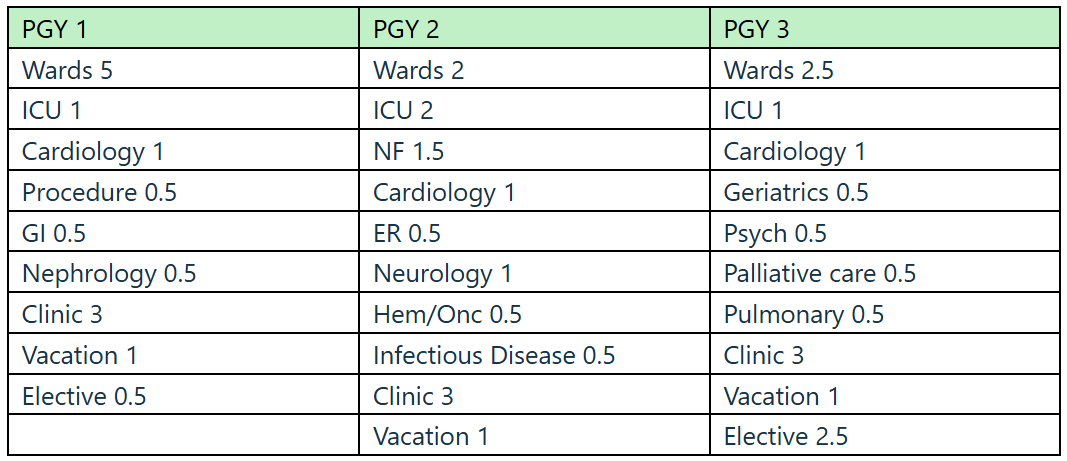Internal Medicine Residency Curriculum
X+Y Block Schedule:
4 weeks rotation then 2 weeks of continuity resident clinic. This is an integral part of our well-being plan, guaranteeing that you are never far away from a two-day weekend (AKA golden weekend). You will not have continuity clinic duties on inpatient or elective rotations.
Our curriculum follows the “learner-manager-teacher” model in that PGY1 residents are predominantly supervised by PGY3 seniors and PGY2 seniors have dedicated time one-on-one with attendings. There is no 24 hour call since night coverage is covered by night float with an attending nocturnist from the hospital’s hospitalist service.
We have a dedicated POCUS and procedure curriculum that ensures residents are trained in common hospitalist procedures, including central lines, arterial lines, intubations, paracentesis, thoracentesis, lumbar puncture, arthrocentesis, suturing, and skin biopsy.
We make sure you get the required 10 months of inpatient and 10 months of outpatient experiences within your 36-month residency. Every resident will be able to spend at least 6 months over the course of their training in rotations geared towards their career goals.
Sample Schedule:

Electives:
- Women’s Health
- Cardiology
- Infectious Disease
- Gastroenterology
- Nephrology
- ER
- Hematology/Oncology
- Pulmonary
- Dermatology
- Psychiatry
- Geriatrics
We will try to honor any other requests if that service is available at Shannon
Academics:
Didactics:
ACGME requires at least 4 hours of didactics per week. We have a protected Academic Half Day from 1 pm to 5 pm every Wednesday. Every resident will be excused from clinical duties during this protected time. Residents on night float or leave such as vacation will be excused. Topics will not only include typical internal medicine subjects but also business of medicine, ethics, safety events/M&M, interprofessional services, quality improvement, etc.
Afternoon Report:
Resident-led case presentations twice weekly while on inpatient services. This is the traditional “morning report” but just at the end of the day so that clinical work is not disrupted. Attendings including specialists are invited to participate.
Ambulatory curriculum:
Short lectures four times a week at lunchtime while on the continuity clinic. These will focus on a wide range of topics specific to outpatient internal medicine.
Journal Club:
Held once monthly. Resident-led.
POCUS Club:
Held once monthly. Scanning with attending and/or senior resident combined with presentation of any interesting case.
Wellness and Annual Retreats:
Residents-led committee plans and hosts a monthly wellness activity for all residents who choose to attend. Biannual retreats are held for each class separately that involve guest faculty short lectures and a time to give feedback to the Program Director. These are great times for residents to build relationships together and with faculty.
Career Coaching:
The Program Director will meet with each resident about every 6 weeks for check-ins, feedback, and career coaching. Each resident will have an additional faculty mentor. We encourage residents to find a mentor in their career path. This typically occurs organically, but the program leadership will help make connections if needed.
Semiannual Reviews:
Each resident will meet with either the Program Director or Associate Program Director twice yearly to review their Clinical Competency Committee review. We hope this is a time of growth for each resident.
Quality Improvement and Scholarly Activities:
Each resident is required to complete at least one QI project in their three years of residency as well as two scholarly projects. It is highly encouraged to present at a conference on the local, state or national level. Time and financial support are available.
Moonlighting:
Residents are encouraged to obtain their state license after finishing PGY1. Moonlighting is approved on a case-by-case basis by the Program Director. It cannot exceed 80-hour work duty hours.
Volunteerism:
Residents are required to participate in two volunteer activities per year. Residents are allowed to choose these activities and do not have to be related to the medical field.
